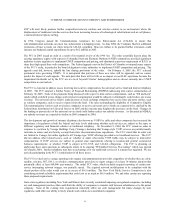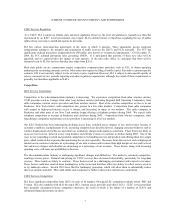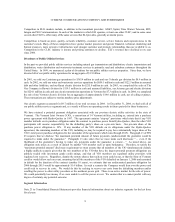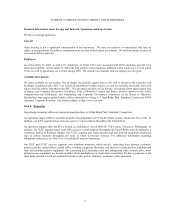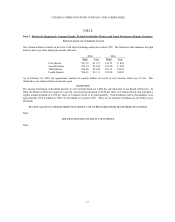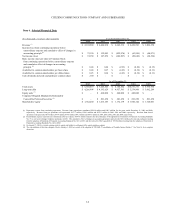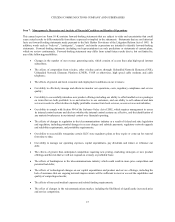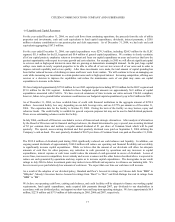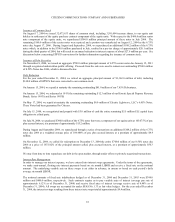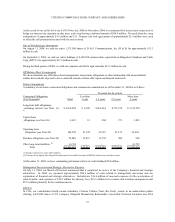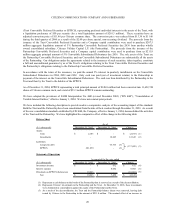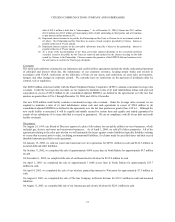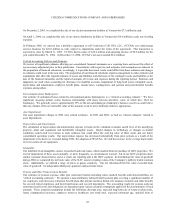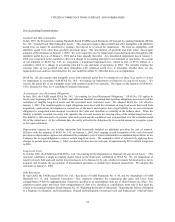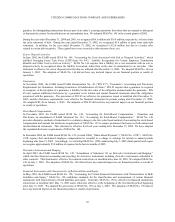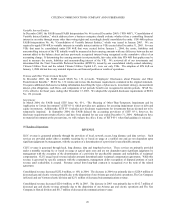Frontier Communications 2004 Annual Report Download - page 18
Download and view the complete annual report
Please find page 18 of the 2004 Frontier Communications annual report below. You can navigate through the pages in the report by either clicking on the pages listed below, or by using the keyword search tool below to find specific information within the annual report.
CITIZENS COMMUNICATIONS COMPANY AND SUBSIDIARIES
16
xThe effects of state regulatory cash management policies on our ability to transfer cash among our subsidiaries and
to the parent company;
xOur ability to successfully renegotiate expiring union contracts covering approximately 78 employees that are
scheduled to expire during 2005;
xOur ability to pay a $1.00 per common share dividend annually may be affected by our cash flow from operations,
amount of capital expenditures, debt service requirements, cash paid for income taxes and our liquidity;
xThe effects of any future liabilities or compliance costs in connection with environmental and worker health and
safety matters;
xThe effects of any unfavorable outcome with respect to any of our current or future legal, governmental, or
regulatory proceedings, audits or disputes; and
xThe effects of more general factors, including changes in economic conditions; changes in the capital markets;
changes in industry conditions; changes in our credit ratings; and changes in accounting policies or practices
adopted voluntarily or as required by generally accepted accounting principles or regulators.
You should consider these important factors in evaluating any statement in this Form 10-K or otherwise made by us or on our
behalf. The following information is unaudited and should be read in conjunction with the consolidated financial statements
and related notes included in this report. We have no obligation to update or revise these forward-looking statements.
Overview
We are a communications company providing services to rural areas and small and medium-sized towns and cities as an
incumbent local exchange carrier, or ILEC. We offer our ILEC services under the “Frontier” name. In addition, we provide
competitive local exchange carrier, or CLEC, services to business customers and to other communications carriers in certain
metropolitan areas in the western United States through Electric Lightwave, LLC, or ELI, our wholly-owned subsidiary.
Competition in the telecommunications industry is increasing. We experience competition from other wireline local carriers,
VOIP providers such as Vonage, from other long distance carriers (including Regional Bell Operating Companies), from
cable companies and internet service providers with respect to internet access and cable telephony, and from wireless carriers.
Most of the wireline competition we face is in our Rochester, New York market, with competition also present in a few other
markets. Competition from cable companies and other high-speed internet service providers with respect to internet access is
intense and increasing in many of our markets. The cable company in Rochester and other parts of our New York markets
began offering a telephony product during 2004. We expect cable telephony competition to increase in Rochester and
elsewhere during 2005. Competition from wireless companies and other long distance companies is increasing in all of our
markets.
The telecommunications industry is undergoing significant changes and difficulties. The market is extremely competitive,
resulting in lower prices. Demand and pricing for certain CLEC services have decreased substantially, particularly for long-
haul services. These trends are likely to continue and result in a challenging revenue environment. These factors could also
result in more bankruptcies in the sector and therefore affect our ability to collect money owed to us by carriers. Several long
distance and IXCs have filed for bankruptcy protection, which will allow them to substantially reduce their cost structure and
debt.
This could enable such companies to further reduce prices and increase competition.
Revenues from data services such as high-speed internet continue to increase as a percentage of our total revenues and revenues
from high margin services such as local line and access charges and subsidies are decreasing as a percentage of our revenues.
These factors, along with increasing operating and employee costs will cause our cash generated by operations to decrease.


